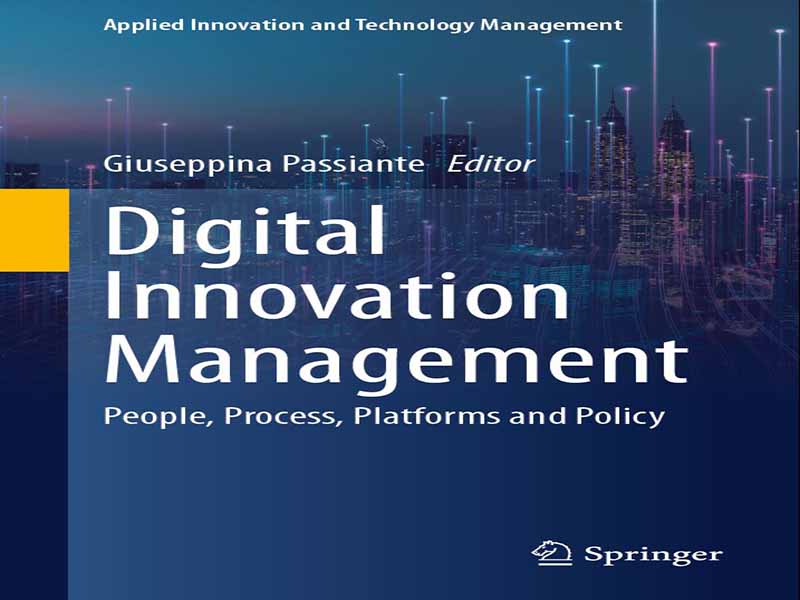- عنوان کتاب: Digital Innovation Management – People, Process, Platforms and Policy
- نویسنده: Tugrul U Daim
- حوزه: مدیریت نوآوری
- سال انتشار: 2025
- تعداد صفحه: 205
- زبان اصلی: انگلیسی
- نوع فایل: pdf
- حجم فایل: 12.9 مگابایت
فنآوریهای دیجیتال ماهیت و ساختار محصولات و خدمات را بهطور اساسی تغییر دادهاند و مسیرهای جدیدی برای ایجاد ارزش و تخصیص ارزش ارائه میدهند. نوآوری دیجیتال همچنین زنجیرههای ارزش و سیستمهای ارزش سازمانها را دوباره پیکربندی میکند و به آنها امکان میدهد سریعتر، انعطافپذیرتر شوند و بتوانند به سرعت به چالشهای غیرمنتظره و فرصتهای نوظهور رسیدگی کنند. انتشار تصاعدی فناوریهای دیجیتال، قوانین بازارها و صنایع «سنتی» و روشهای تلفیقی را که شرکتها در آن در سناریوی رقابتی جهانی عمل میکنند، تغییر میدهد. مدل کسبوکار «دیجیتال در هسته»، روشی جدید برای ایجاد ارزش از طریق فناوریها، امروزه بهعنوان چارچوب رقابتی کلیدی برای حمایت از سازمانهایی که صرفنظر از اندازه، مکان و صنعت، هدفشان رقابت در اقتصاد دیجیتال است، غالب است. با این حال، مدل کسبوکار «دیجیتال در هسته» تنها در صورتی موفق است که با نرخهای یادگیری سریع و ظرفیت سازمانها برای بهرهبرداری و ادغام مؤثر مجموعهای از داراییهای دانش بازار و فنآوری که در سطح محلی و جهانی در حال تکامل هستند، پشتیبانی شود. از منظر اجتماعی، انتشار فناوری های دیجیتال تغییرات قابل توجهی را در سبک زندگی و رفتار مردم ایجاد کرده است، بنابراین شرکت ها و ادارات دولتی را مجبور می کند که فرآیندهای تحول دیجیتال خود را تسریع بخشند. بنابراین، نفوذ فناوریها در سازمانها، صنایع و جوامع به تأیید یک پدیده اجتماعی-فنی و روند ترکیبی کمک میکند که به آن نوآوری دیجیتال میگویند. در نتیجه، میتوان به مدیریت نوآوری دیجیتال به عنوان مجموعهای از شیوهها، فرآیندها و اصولی اشاره کرد که زیربنای هماهنگی مؤثر نوآوری دیجیتال است و با هدف توسعه روابط نزدیک و مبتنی بر اعتماد بین سازمانها و ذینفعان آنها با هدف دستیابی به نتایج تجاری و در عین حال تضمین پایداری اجتماعی و زیستمحیطی انجام میشود. وابستگی متقابل فضیلتآمیز بین سازمانها و افراد نیز تحت تأثیر نهادهایی قرار میگیرد که به ایجاد و حفظ الگوهای مؤثر تعامل اجتماعی در یک قلمرو فراخوانده میشوند. همه این بازیگران از نزدیک به هم مرتبط هستند و به ایجاد خوشه های صنعتی نوآورانه کمک می کنند که بتوانند نرخ نوآوری اقتصادهای منطقه را افزایش دهند. این “محیط های خلاق” به عنوان اکوسیستم های نوآوری دیجیتال شناخته شده اند، به عنوان مثال. سیستمهای پژوهش، نوآوری و آموزش یکپارچه و دیجیتالی فعال که هم افزایی پویا را بین مؤسسات تحقیقاتی، سازمانهای مالی، کارآفرینان و کارشناسانی که در تعامل مستمر برای تولید دانش، شایستگیها و نوآوری جدید کار میکنند، ترویج و تقویت میکند. نمونهای از این اکوسیستمها شهر هوشمند است که در آن سرمایهگذاری در فناوریهای اطلاعات و ارتباطات (ICT)، زیرساختهای فناوری و خدمات دیجیتال با هدف تضمین توسعه اقتصادی پایدار و کیفیت بالای زندگی، تغییر فضایی سرزمینها با ادغام مجاورت جغرافیایی با نزدیکی رابطهای انجام میشود. پارادایم نوآوری دیجیتال شامل چهار بعد یکپارچه است که در این کتاب به عنوان بلوک های سازنده سناریوی اجتماعی-فنی در حال ظهور پذیرفته شده است: (1) مردم، یعنی. عوامل فردی و موتور اصلی تحول مبتنی بر فناوری؛ (2) فرآیند، به عنوان مثال. روش، مکانیسم و فضایی که از طریق آن نوآوری در واقع اتفاق می افتد. (3) پلت فرم، یعنی. سیستم یکپارچه راه حل ها و ابزارهای محرک تحول؛ و (4) خط مشی، یعنی. لایه نهادی که از دگرگونی های فنی-اجتماعی حمایت و حفظ می کند. پیرامون چنین چهار بعد، ساختار کتاب در ده فصل بیان شده است که اجمالی اجمالی مربوط به جریان نوظهور تحقیقات در زمینه نوآوری دیجیتال و مدیریت نوآوری دیجیتال را ارائه می دهد. در سخنان افتتاحیه، فصل اول توسط Passiante و همکاران. چالش های فعلی مدیریت نوآورانه در اقتصاد دیجیتال را برجسته می کند. در بخش افراد، Secundo و همکاران. هدف بررسی قابلیتهای پویا برای یک دوره دیجیتالی تبدیل شده است در حالی که Ndou و همکاران. تمرکز بر شایستگی ها و مهارت های حیاتی برای سفر دیجیتالی در بخش مدیریت دولتی. در بخش فرآیند، مارگریتا و همکاران. تجزیه و تحلیل نوآوری دیجیتال در مدیریت منابع انسانی برای ایجاد سازمان های مردم محور در حالی که الیا و همکاران. نتایج آزمایش نوآوری دیجیتال در فرآیند لجستیک معکوس را برجسته کنید. در بخش پلتفرم، Solazzo و همکاران. نقش فنآوریهای دیجیتال برای مدیریت انرژی و بهویژه برای حمایت از جوامع انرژیهای تجدیدپذیر را تحلیل میکنند، در حالی که لورنزو و همکاران. تمرکز بر پلتفرمهای هوش مصنوعی که رباتهای گفتگوی مکالمه را فعال میکنند..
Digital technologies have radically changed the nature and structure of products and services, offering new value-creation and value-appropriation pathways. Digital innovation is also reconfiguring the organisations’ value chains and value systems, allowing them to become faster, more flexible and able to rapidly address unex¬pected challenges and emerging opportunities. The exponential diffusion of digital technologies is transforming the rules of ‘traditional’ markets and industries, and the consolidated ways in which companies operate in the global competitive scenario. A ‘digital-at-the-core’ business model, a new way of creating value through technologies, dominates today as the key com-petitive framework to support those organisations which, regardless of size, location and industry, aim to compete in the digital economy. However, the ‘digital-at-the-core’ business model is successful only if it is supported by fast learning rates and the capacity of organisations to leverage and integrate effectively an array of fast-evolving market and technology knowledge assets available at local and global level. From a societal perspective, the diffusion of digital technologies has introduced significant changes in people’s lifestyle and behaviour, thus forcing companies and public administrations to accelerate their digital transformation processes. The pen¬etration of technologies within organisations, industries and societies is thus con¬tributing to the affirmation of a socio-technical phenomenon and composite trend which is termed digital innovation. Consequently, we can refer to digital innovation management as the set of practices, processes and principles that underlie the effec¬tive orchestration of digital innovation, and which are aimed to develop close, trust-based relationships among organisations and their stakeholders aiming to achieve business results while guaranteeing socio-environmental sustainability. Virtuous interdependences among organisations and individuals are also influ¬enced by institutions, which are called to create and sustain effective patterns of social interaction within a territory. All such actors are closely interconnected, and contribute to create innovative industrial clusters able to increase the innovation rate of regional economies. These ‘creative environments’ have been characterised as digital innovation eco¬systems, i.e. integrated and digitally enabled systems of research, innovation and education that promote and foster dynamic synergies among research institutions, financial organisations, entrepreneurs and experts working in continuous interaction to generate new knowledge, competencies and innovation. An example of such eco¬systems is the smart city, where investments in Information and Communication Technologies (ICTs), technological infrastructure and digital services are aimed to ensure sustainable economic development and a high quality of life, changing the spatiality of territories by integrating geographical contiguity with relational proximity. The paradigm of digital innovation includes four integrated dimensions, which are adopted in this book as building blocks of the emerging socio-technical sce¬nario: (1) People, i.e. the individual agents and core engine of technology-based transformation; (2) Process, i.e. the modality, mechanism and space through which the innovation actually happens; (3) Platform, i.e. the integrated system of solutions and tools driving the transformation; and (4) Policy, i.e. the institutional layer that supports and sustains socio-technical transformation. Around such four dimensions, the structure of the book is articulated in ten chapters, which offer relevant glimpses into the emerging stream of research on digital innovation and digital innovation management. In the Opening Remarks, the first chapter by Passiante et al. highlights the cur¬rent challenges of innovative management in the digital economy. In the People section, Secundo et al. aim to investigate dynamic capabilities for a digitally trans¬formed era whereas Ndou et al. focus on crucial competencies and skills for a digital journey within the public administration sector. In the Process section, Margherita et al. analyse digital innovation in the human resource management to generate people-centred organisations whereas Elia et al. highlight the results of an experiment of digital innovation in the reverse-logistics process. In the Platform section, Solazzo et al. analyse the role of digital technologies for energy management and in particular for supporting renewable energy communi¬ties, whereas Lorenzo et al. focus on artificial intelligence platforms that enable conversational chatbots and Girardo et al. emphasise the smart city as a model of digital innovation for urban development. In the Policy section, Mele et al. focus on digital innovation ecosystems for sus¬tainable growth, whereas Petti et al. discuss the main issues of digital transforma¬tion in international education. Finally, since digital innovation is a multi-stakeholder process, each chapter is co-authored by academicians and professionals working in private companies or public institutions, in the aim to provide readers with an integrated perspective of such complex phenomenon.
این کتاب را میتوانید از لینک زیر بصورت رایگان دانلود کنید:
Download: Digital Innovation Management



































نظرات کاربران